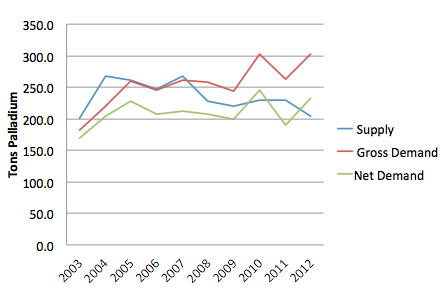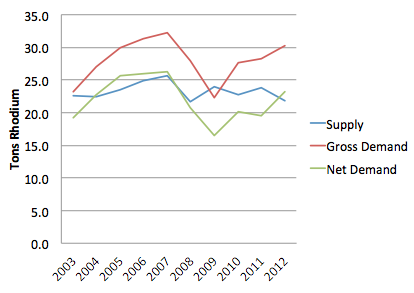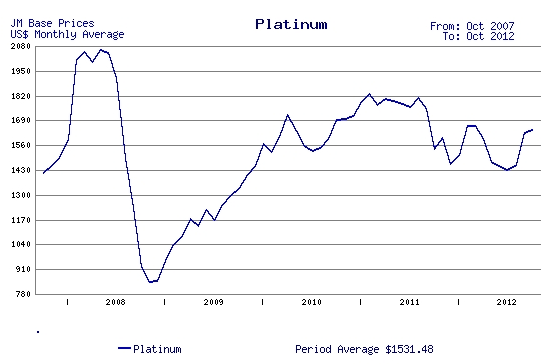Description of Problem
Platinum Group Elements (PGEs) are used in a wide range of technologies, including catalytic converters, electronics, and jewelry. Overall, catalytic converters and autocatalysts are the largest single contributors to demand for PGEs, with jewelry coming in second place("Market data tables," 2012). Due to the use of PGEs in catalytic converters, an increase in demand for cars or stricter emissions requirements would result in an increase in demand of PGEs. As populations continue to grow, and greenhouse gases continue to rise, PGE demand will grow at a higher rate than the growth of the economy (Kosich, 2012).
Platinum
In the short term, platinum demand is expected to remain constant, with only slightly increasing projections ("Current and historical," 2012). Overall, platinum demand is expected to increase 3.5%. Jewelry, auto, and coin demand are all expected to rise. Auto demand especially is expected to rise strongly as the Japanese market recovers. As one can see, this is not a deviation from historic platinum demand.
Historic Platinum Supply and Demand

Data Source: ("Market data tables," 2012)
Meanwhile, CPM expects the total platinum supply to decrease by 1.6% due to lower mine productions by mines in South Africa and Russia. Secondary supply is also expected to decrease due to lower scrap metal and platinum prices.
Palladium
Palladium supply is expected to drop 0.06 million ounces from 2011. Meanwhile, Palladium prices are expected to rise above the prices of platinum. Again, there is a trend of increasing demand (3.5%) with decreasing supply.
Historic Palladium Supply and Demand

Data Source: ("Market data tables," 2012)
Rhodium
There are significant improvements in rhodium processing and mining, therefore there has actually been a growth in rhodium supply (2.6%), while demand for rhodium has risen (1.3%).
Historic Rhodium Supply and Demand

Data Source: ("Market data tables," 2012)
There is an overall general trend of decreasing supply and increasing demand.
Case Study
Platinum group elements (PGEs) face a very different problem than that of other strategic metals. Despite the fact that the Bushveld Complex mine in South Africa has the resources to supply world demands for platinum for the next century, miners' strikes complicate the economic stability of PGEs. As previously mentioned, South Africa is largely responsible for the global production of PGEs. Despite the adequate resources to fulfill world demand for PGEs, their prices have recently skyrocketed due to strikes at South African mines.
In November 2012, an eight-week long strike of Anglo American Platinum Ltd. workers in South Africa ended, but only after crippling their business. While the workers only received 2.5% of the monthly salary raise they demanded, the strike has already financially burdened Anglo American Platinum Ltd., as well as the market for PGEs. For example, during the strikes the market price for platinum skyrocketed close to 200 USD per ounce from 1430 USD to 1600 USD. As a result of the strikes, Anglo American might close some of its mines in South Africa, causing an even greater decrease in supply of PGEs and a subsequent increase in price. Therefore, it is clear that the economic stability of PGEs is shaky at best; prices are expected to continue to rise as labor and political instabilities continue to plague South African mines. It is clear that in order for price stability to be obtained, something needs to be done to ensure labor and political stability.
Platinum Price History

Source ("Market data tables," 2012)
Timeline–how long we have to solve the problem
There is an overall trend of increasing demand with decreasing supply. Inaction would result in demand entirely surpassing supply.
a) 2013: Recycling for platinum materials goes out of business.
b) 2020: Platinum no longer mined in Kenya and decreased overall mining production due to continued massive humanitarian strikes.
c) 2034: China stops selling platinum to the rest of the world, prices increase by 20,000%
d) 2050: Run out of platinum; platinum no longer used in jewelry, cars, and coins.
Cost of Inaction
Platinum Demand x Price: 8,070,000 oz (4) x 1573 (3)= $12,694,110,000
-Looking at figures from ("Market data tables," 2012), we see that demand for rare earth materials is fairly similar across the board:
(Iridium) x Price: 8,000,000 oz x 1050= $8,400,000,000
(Rhodium) x Price: 8,000,000 oz x 635= $5,080,000,000
(Palladium) x Price: 8,000,000 oz x 1100= $8,800,000,000
(Ruthenium) x Price: 8,000,000 oz x 090= $720,000,000
Sum = $35,694,110,000 could potentially be lost if we were to ignore the problem of increasing demand and decreasing supply.
[1](2012). Market data tables. Platinum today, Retrieved from http://www.platinum.matthey.com/publications/market-data-tables/
[2]Kosich, D. (2012, June 26). Platinum demand to substantially outstrip supply in 2012 - cpm. Mineweb, Retrieved from http://www.mineweb.com/mineweb/content/en/mineweb-platinum-group-metals?oid=154047&sn=Detail&pid=102055
[3](2012). Current and historical prices. Platinum today, Retrieved from http://www.platinum.matthey.com/cgi-bin/dynamic.pl?template=historical
[4] http://www.platinum.matthey.com/uploaded_files/Int_2012/pt_03_to_12.pdf
[5]http://www.washingtonpost.com/business/south-african-miners-return-to-work-at-anglo-american-
platinum-mine-ending-8-week-strike/2012/11/15/e7843294-2f05-11e2-af17-67abba0676e2_story.html

